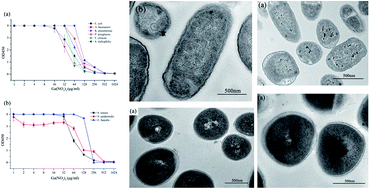Antimicrobial effect of gallium nitrate against bacteria encountered in burn wound infections
Abstract
Recently, biomaterials have been increasingly used for burn wound healing, but burn wound infections and biomaterial-associated infections still need to be addressed. As a novel inorganic antimicrobial, the antimicrobial effect of gallium nitrate was investigated, and the minimum inhibitory concentration (MIC) of gallium nitrate against bacteria that are common in infected burn wounds was determined with a Microbial Viability Assay Kit-WST. The results showed that the MIC of Ga(NO3)3 against E. coli and E. faecalis was 256 μg mL−1, and it was 512 μg mL−1 against P. aeruginosa, K. pneumonia, E. cloacae, A. baumannii, S. maltophilia, S. aureus and S. epidermidis. Meanwhile, transmission electron microscopy (TEM) found similar visual evidence of the mechanism by which the gallium ion attacks both Gram-negative and Gram-positive bacteria, which was in agreement with the MIC results. By TEM observation, it was found that detachment of the cell membrane and wall and the appearance of an electron-light region containing condensed substances occurred in both Ga3+-treated E. coli and Ga3+-treated S. aureus cells, with smaller morphological changes in Ga3+-treated S. aureus compared with E. coli. This research shows the effective and wide-spectrum antimicrobial properties of gallium nitrate against most bacteria encountered in burn wound infections. Gallium(III) could be a good choice when fighting an infected burn wound, and it is a promising candidate for modifying biomaterials or medical devices to prevent infection in burn wounds.



 Please wait while we load your content...
Please wait while we load your content...